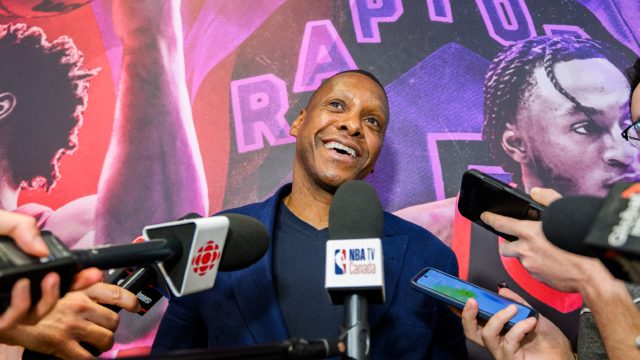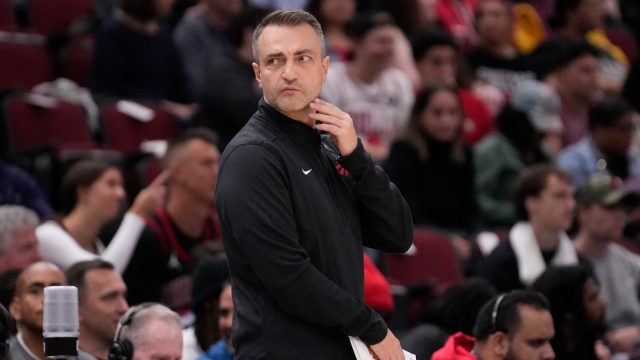
TORONTO — Sasha Vezenkov’s desire to return to Greece has slightly reshaped what the remainder of the Toronto Raptors’ off-season could look like.
The Raptors announced Monday that they have waived Vezenkov, along with Javon Freeman-Liberty. Freeman-Liberty was the usual, albeit unfortunate, result of mid-summer guarantee dates and roster crunches (more on him later). The Vezenkov situation, though, ends several weeks of intrigue around the former EuroLeague standout. It also came at quite a cost to the player.
Vezenkov will receive zero of the $6,658,536 that was set to be guaranteed to him this year.
Why? It was his clearest path back to Greece.
Vezenkov signed a three-year deal last summer with Sacramento, who had previously acquired his 2017 draft rights from Cleveland, who had acquired them from Brooklyn, who took him 57th overall in 2017. An agreement exists between the NBA and FIBA that governs the movement of players back and forth, and so Sacramento had to wait until he was a free agent overseas and had an interest in coming to the NBA. To lure him over, they guaranteed him $13 million, with a team option for 2025-26.
A guaranteed contract works both ways. Vezenkov did not have a player option for 2024-25, and so when reports surfaced that he wanted to return overseas, he couldn’t just leave; the NBA-FIBA agreement wouldn’t allow him to break a contract with his NBA team. Vezenkov’s previous team, Olympiacos, with whom he became among the most accomplished EuroLeague players of the last decade, has reportedly offered him a substantial deal to return if he could secure his NBA release.
The Raptors knew this was a possibility when they took on Vezenkov in a trade that was largely a salary-clearing move for the Kings. The “if” in Olympiacos’s reported offer, then, became a leverage point. If Vezenkov really wanted to return, the Raptors weren’t just going to waive him and eat the $6.7 million in salary, along with the cap hit and potential luxury tax implications. The Raptors had additional leverage in that they held a team option for 2025-26 on Vezenkov — this could have dragged out for two years if there was a bad stalemate.
Neither side wanted that, of course, and the Raptors were down to cooperate with Vezenkov’s camp (relationships are important!) for the right price. Toronto wasn’t going to pay him to go play in Greece, and it figured that a buyout figure would trim at least a good chunk of salary off the Raptors’ books.
In the end, Vezenkov made a nearly unprecedented move, walking away from his entire salary. The reported terms of the Olympiacos deal, if accurate, will make him more than whole, especially since many European deals are net of taxes, whereas NBA deal figures are before tax.
Once it was clear Vezenkov was willing to walk away entirely, the Raptors likely had one final step of canvassing the league to see if anyone wanted the contract to buy it out themselves. The Grizzlies, for example, may have been interested in trading Ziaire Williams for Vezenkov, instead of the deal made with Brooklyn for Mamadi Diakite, as they could have then bought Vezenkov out for $0 and cleared out similar breathing room under the tax.
The Nets received a 2030 second-round pick for their troubles; the Raptors would have surveyed the market to see what asset they could get back to “rent out” the potential Vezenkov cap space, and weighed that against the value of using the space themselves.
(As for why the Kings didn’t just go this path with Vezenkov instead of attaching two second-round picks to him and Davion Mitchell in a salary dump, it’s likely a matter of timing. They couldn’t, or didn’t want to risk, waiting on the DeMar DeRozan signing, and/or losing leverage in trade or buyout negotiations by being in luxury tax territory after that addition. I’m sure they’d have preferred that route if the stars aligned.)
Why Javon Freeman-Liberty, though?
As mentioned, Freeman-Liberty’s release was of a different kind. His contract for 2024-25 was only guaranteed for $100,000, and that only increased to $150,000 if he remained on the roster past tomorrow (and $800,000 on opening day). That’s a very reasonable guarantee amount for a player who’s shown real flashes, but three factors were working against Freeman-Liberty here.
The first is that teams generally prefer trying something new over someone they’ve had a long look at. While that can seem a bit backward – you know the player! You’ve invested time into them! Teams taking a flier on a different developmental piece coming out of Summer League happens fairly regularly.
The second, and probably more relevant factor is that the Raptors have a lot of backcourt pieces vying for NBA minutes now, as well as a handful of backcourt developmental pieces. Freeman-Liberty’s path to a role would have to go through Davion Mitchell, Ja’Kobe Walter, and Jamaal Shead now, while D.J. Carton is also around on a two-way deal. Freeman-Liberty became harder to slot in, on paper, as an undersized slash-and-transition two-guard who’d shown moderate, but not enormous, gains in his point guard play.
To be clear, I still like Freeman-Liberty and have been a believer in him as a depth piece for a while. Which brings us to the third factor: Sometimes teams let a guy go to seek a better opportunity they’re no longer sure they can provide. Freeman-Liberty will have NBA suitors for a two-way contract if he opts to go that route versus competing for a roster spot in training camps.
The Raptors do not hold his G League rights, so while a Raptors 905 reunion is not impossible, they’d have to acquire those rights and wait for Freeman-Liberty to go unsigned or be waived from wherever he lands. That seems fairly unlikely.
Where the Raptors’ roster and cap sheet stand now
We covered most of the Raptors’ off-season moves last week but Monday’s releases change two key parameters.
One, the Raptors now have multiple roster spots open. They currently have 14 players under guaranteed NBA contracts, three two-way players, and one Exhibit 10 (Jamison Battle; basically a camp/905 contract) player, plus a second Exhibit 10 player (Quincy Guerrier) reported but not official. Teams can have up to 21 players under contract in total during the off-season, so even with Guerrier, the Raptors have two open spots, including one open spot for their opening-day roster.
Two, the Raptors now have about $11.3 million in wiggle room underneath the luxury tax, before factoring in unlikely incentives (explained in last week’s piece).
The off-season looked more or less finished a few days ago. Now there are two roster spots and a big chunk of change available to play with.
What the Raptors can do with the extra space
The sexy option is to use the newfound space under the tax and use the full mid-level exception, which starts at $12.8 million and can go up to four years. They would have to trim some salary somewhere to use the full amount and avoid the tax, or they could offer a deal that’s close to the full mid-level but not all the way. The free agent bin is not exactly enthralling at this point in the summer, but Tyus Jones can help any team and would hold value as a trade chip once eligible, for example.
A more modest option would be to spend a little bit of the mid-level, maintaining some flexibility under the tax. The Raptors could target a pool of players who aren’t as good as Jones but may better fill a roster need, like Lonnie Walker IV, Doug McDermott, Talen Horton-Tucker, JT Thor, Precious Achiuwa, Cedi Osman, or any number of older vets. This would allow the Raptors to fill out the roster, add some bench talent, and in many cases, add a possible deadline trade chip if the fit isn’t there or the team isn’t that good.
The flexibility-forward move would be to use the two spots on two additional Exhibit 10 or small-guarantee types, guys who could compete in training camp for a roster spot or add Raptors 905 depth later. Names like Christian Koloko (if cleared by the NBA), JT Thor, Usman Garuba, Dominick Barlow, Lester Quinones, and a handful of undrafted free agents or Summer League standouts could fit the bill. Really, this pool is endless and is very “eye-of-the-beholder.” In this scenario, the Raptors’ opening-day rotation wouldn’t look much different, but they’d have another potential developmental piece when the dust settles and would maintain almost all of their financial flexibility.
About that flexibility. They might just choose that last route and keep things flexible. Having $11.3 million in wiggle room for trades is valuable, even if it doesn’t move the needle a ton for fans. We just saw with the Kings trade how valuable even a few million in space to rent out can be, and the Raptors remain in asset-acquisition mode. Keeping that space to take on extra salary in a Bruce Brown trade, a Chris Boucher trade, or a straight salary-dump trade could bring back another valuable pick later. That’s especially true under this new CBA, where a team can use their mid-level exception as a trade exception, too – the Raptors could just eat $11.3 million in salary from a team trying to lessen their tax bill and pick up assets for it. Again, not the sexiest route, but it’s one way of using your flexibility.
(And yes, there’s a more exciting and less likely scenario where the space, in addition to the assets they currently have, are used to add meaningfully via trade. That’s a harder path to figure until a Brown scenario clarifies.)
What’s next?
Probably nothing, imminently, other than all of us enjoying some Olympic basketball and what will probably be an underwhelming Blue Jays deadline sell-off. The Raptors will eventually fill those two roster spots, and who they target will give us a good indication of which of the paths above they’re taking with the post-Vezenkov tax breathing room.






